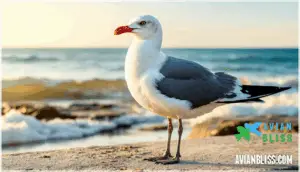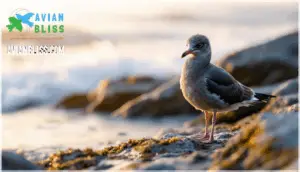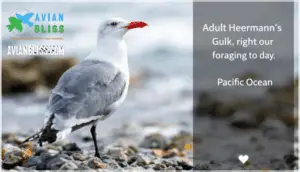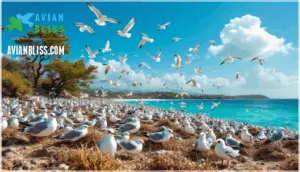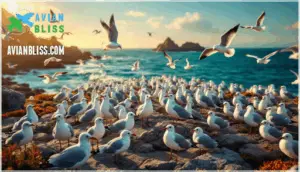This site is supported by our readers. We may earn a commission, at no cost to you, if you purchase through links.

After nesting season ends, they don’t stick around. These gray-bodied gulls with striking red bills migrate north along the Pacific Coast, appearing on beaches from Baja to British Columbia. You’ll spot them stealing fish from pelicans, diving for anchovies, or loafing on rocky shores where cold currents stir up abundant prey.
Table Of Contents
- Key Takeaways
- Heermann’s Gull Identification and Features
- Natural Habitat and Geographic Range
- Feeding Behavior and Diet
- Breeding Biology and Life Cycle
- Conservation Status and Challenges
- Frequently Asked Questions (FAQs)
- What is an immature heermanns gull?
- What do Heermann’s gull eat?
- What is the average lifespan of Heermanns Gulls?
- How do Heermanns Gulls communicate with each other?
- Are Heermanns Gulls known for any unique behaviors?
- Do Heermanns Gulls have any natural predators?
- What historical significance does Heermanns Gull hold?
- How does climate change affect Heermanns Gulls?
- What sounds do Heermanns Gulls make?
- How long do Heermanns Gulls live?
- Conclusion
Key Takeaways
- Over 95% of the world’s Heermann’s Gulls breed on a single Mexican island (Isla Rasa), making this concentration both a conservation success story and a critical vulnerability point for the entire species.
- These gulls are skilled kleptoparasites who aggressively steal fish mid-flight from Brown Pelicans and other seabirds rather than relying solely on hunting, defining their survival strategy along the Pacific Coast.
- The population has grown sixfold since 1975 to roughly 350,000 breeding adults due to targeted conservation efforts, yet climate-driven ocean warming and prey depletion caused catastrophic breeding failures in 2016.
- After breeding season, Heermann’s Gulls migrate thousands of miles north from Mexico to British Columbia following the California Current, tracking seasonal fish abundance before returning south in late fall.
Heermann’s Gull Identification and Features
Heermann’s Gulls stand out from other coastal birds with their striking appearance. You’ll notice their deep gray bodies, white heads, and bright red bills right away. Here’s what makes them easy to spot and identify in the field.
Adult Plumage and Coloration
If you’ve ever spotted a gull that looks completely different from the white and gray birds you’re used to seeing, you might’ve just locked eyes with a Heermann’s Gull—the rebel of the gull world with its striking dark plumage and bold red bill.
Adults break the mold with their distinctive gull characteristics. Here’s what sets them apart:
- Deep gray body plumage with a contrasting pearly white head that demands attention during breeding season
- Bright red bill paired with black legs, creating an unmistakable color combination unlike any other gull species
- Black tail feathers that complete the moody aesthetic, making identification straightforward in the field
This color morphs dramatically from their drab juvenile plumage. Their breeding plumage represents peak boldness—a striking palette that screams confidence. That feather texture? Sleek and refined. The molt cycles follow seasonal patterns, shifting their head from white to mottled between breeding seasons. You can’t miss them once you know what to look for.
Immature Gull Appearance
Young Heermann’s Gulls look nothing like their flashy parents, wearing a smooth dark brown or gray-brown coat that makes them blend into their surroundings rather than stand out. This juvenile plumage masks their identity during feather development stages. Their beak color shifts from pinkish at the base to darker tones.
As molt stages progress, these gull characteristics gradually transform, with plumage patterns emerging that eventually match adult coloration. This gradual shift in bird species identification helps you track their maturation across breeding seasons.
Bill, Legs, and Size Details
Once you move past the juvenile plumage, an adult Heermann’s Gull reveals the striking details that make it instantly recognizable—a bright red bill, black legs, and a compact frame built for piracy. Here’s what sets them apart:
- Bill Color – The bright red bill stands out against the gray body and makes spotting these aggressive foragers easy.
- Leg Structure – Black legs provide contrast and support their active hunting lifestyle along Pacific waters.
- Measurements – Adults measure 18–21 inches, giving them the size and agility needed for stealing food from larger birds.
- Beak Shape – The pointed bill lets them snatch fish mid-flight or pluck prey directly from pelican pouches.
- Relative Size – Despite their compact frame, their bold behavior makes them formidable hunters among other seabirds.
This bird species identification matters because you’ll spot them working the coast with unmistakable style and aggression.
Distinctive Flight Silhouette
When you see a Heermann’s Gull in flight, you’re watching a bird built for stealing fish with exceptional speed and precision. Their compact body and pointed wings create a silhouette designed for quick maneuvers. You’ll notice them darting low over water with fluid, aggressive movements—weaving between pelicans to intercept prey. Their aerodynamic features include swept-back wings that enable rapid acceleration and tight turns. Watch how they glide effortlessly, then suddenly plunge or snatch mid-flight. This distinctive flight pattern reveals a master thief perfectly adapted to coastal hunting.
| Feature | Advantage | Implication |
|---|---|---|
| Swept-back wings | Rapid acceleration | You’ll see sudden bursts of speed |
| Compact body | Agile maneuvers | They execute tight turns effortlessly |
| Low flight pattern | Prey interception | They hunt close to water surface |
| Pointed silhouette | Aerodynamic efficiency | They outlast larger birds in pursuit |
Natural Habitat and Geographic Range
Heermann’s Gulls don’t stick to one place year-round. They’re creatures of movement, following the Pacific Coast like a well-worn migration map.
You’ll find them scattered across different regions depending on the season, each location offering something unique to their survival and success.
Breeding Sites in The Gulf of California
Imagine this: over 90 percent of all Heermann’s Gulls in the world gather on a single island to raise their young. That’s Isla Rasa in the Gulf of California, where roughly 350,000 breeding adults form massive nesting colonies each spring.
Over 90% of the world’s Heermann’s Gulls gather on a single Mexican island each spring to breed
This remote breeding ground sits in nutrient-rich waters that fuel the entire life cycle of Heermann’s Gull populations across North America.
Preferred Coastal and Marine Environments
After breeding wraps up on Isla Rasa, you’ll find Heermann’s Gulls hugging the immediate coast—rocky shores, sandy beaches, estuaries, and offshore kelp beds become their stage. These coastal ecosystems offer everything they need:
- Kelp forests teeming with small fish and crustaceans
- Nutrient-rich ocean currents fueling prey abundance
- Protected estuaries providing shelter during storms
- Rocky shoreline dynamics creating ideal foraging zones
- Marine habitats supporting diverse seabird migration patterns
You won’t spot them at inland dumps or freshwater ponds. They’re ocean-bound specialists thriving where shoreline meets sea.
Seasonal Migration Along The Pacific Coast
Each summer, these gray gulls ride the California Current northward from their Mexican breeding grounds, shadowing Brown Pelicans up the coast in a calculated game of theft and opportunity. You’ll witness their northward flight from June through September, tracking the Pacific Flyway to California, Oregon, Washington, and even British Columbia. By late fall, most reverse course, completing their seasonal movements back to warmer waters.
| Migration Phase | Timing & Direction |
|---|---|
| Northward dispersal | June–September: Gulf of California → Pacific Northwest |
| Peak presence | July–October: California coast & Monterey Bay |
| Southward return | October–December: Back to Mexican breeding sites |
Population Hotspots in North America
You’ll find Heermann’s Gulls concentrated in four key foraging grounds along the Pacific Coast after their northward migration patterns from breeding islands. These coastal colonies and coastal bird species hotspots reveal where conservation efforts matter most:
- Monterey Bay, California – Peak summer through winter populations due to nutrient-rich waters
- British Columbia – 1,500–3,000 gulls annually, with flocks reaching 2,000 birds
- Central California beaches – High densities from late May through early February
- Pacific Northwest shores – Regular seasonal presence tracking Pacific sardine abundance
Understanding the species’ habitat and behavior is essential for implementing effective seabird conservation strategies.
Feeding Behavior and Diet
Heermann’s Gulls don’t just catch their own meals—they’re skilled thieves of the sea. You’ll find them using clever foraging techniques that range from diving for fish to boldly stealing catches from other birds.
Here’s how these opportunistic feeders survive along the Pacific Coast.
Primary Food Sources and Prey
You’ll find Heermann’s Gulls hunting small pelagic fish like Pacific sardines, northern anchovies, and herring in the California Current’s nutrient-rich waters. Their diet also includes smelt, small crustaceans, mollusks, and insects.
These opportunistic feeders won’t pass up bird eggs, carrion, or refuse when you spot them scavenging along the coast.
Foraging Techniques and Kleptoparasitism
Watch a Heermann’s Gull in action, and you’ll see it’s not just a hunter—it’s a master thief, stealing fish straight from a pelican’s bill pouch. This kleptoparasitic behavior defines the species.
Their foraging strategies include:
- Head-dipping to grab surface prey
- Body plunging into shallow water
- Surface picking from kelp beds
- Aerial harassment of Brown Pelicans
- Food piracy through aggressive pursuit
You’ll witness bold prey capture tactics that make this gull species unforgettable during bird watching.
Seasonal Dietary Shifts
During breeding season, over 70% of your Heermann’s Gull’s diet consists of small pelagic fish like Pacific sardine and northern anchovy. Fish availability drives these dietary shifts.
When prey diversity drops in non-breeding months, you’ll notice increased foraging adaptation—crustaceans and mollusks jump by 35%. Nutrient intake fluctuates with migration patterns, shaping feeding behavior across seasons. Heermann’s Gull feeding habits are influenced by their marine habitat characteristics.
Interactions With Other Seabirds
When fish run scarce, Heermann’s Gulls don’t just wait—they steal, and Brown Pelicans pay the price. Kleptoparasitic behavior defines their foraging strategies. You’ll watch them harass pelicans mid-flight, snatching fish straight from bill pouches. This seabird aggression creates intense social interactions:
- Direct theft from pelican catches
- Forcing regurgitation through harassment
- Stealing from cormorants and terns
- Aggressive pursuit until prey drops
These coastal birdwatching moments reveal predator avoidance isn’t just about escape—it’s about who steals first.
Breeding Biology and Life Cycle
Heermann’s Gulls don’t reveal their breeding secrets easily—most of the action happens on remote Mexican islands where they gather in massive colonies. Understanding their nesting behavior gives you a window into one of nature’s most concentrated seabird spectacles.
Let’s break down how these gray gulls pair up, raise their young, and send the future offspring north along the Pacific Coast.
Mating and Pair Bonding Behaviors
Heermann’s Gulls form bonds through courtship displays that blend aggression with tenderness, a dance of territorial posturing and food-sharing rituals that cements their partnership before they ever touch ground on a nesting island. You’ll notice these breeding habits favor monogamy patterns, with pairs returning to breeding colonies year after year.
Mate selection involves aerial chases and synchronized calls. Courtship rituals strengthen pair bonding before the gulls head to their Heermanns Gull habitat on Mexican islands.
Nesting Site Selection and Construction
Once bonded pairs arrive at breeding colonies, they claim a patch of level ground and scrape out a shallow depression—sometimes just bare earth, other times a modest cup lined with dry grass and weeds. Nest architecture stays simple—gulls weave minimal nesting materials into a functional cradle for their clutch.
You’ll find these nesting platforms clustered tight within the colony formation on Isla Rasa and other breeding grounds, where site selection favors flat terrain that shields eggs from wind.
Egg-laying, Incubation, and Chick Care
After the female deposits two or three eggs in the nest, both parents share incubation duties for roughly four weeks, taking turns warming the clutch while the other hunts or guards the territory.
Once chicks hatch, you’ll see both adults deliver regurgitated fish and crustaceans directly into hungry beaks. Young gulls grow fast on this protein-rich diet, and parental care remains intense until chicks can thermoregulate and move around nesting grounds independently.
Fledgling Development and Survival Rates
Growth Patterns show chicks gain eighteen to twenty-two grams daily when fish are plentiful, reaching Fledgling age around forty days. Environmental Impact from warm ocean phases cuts Growth Patterns by thirty percent and survival drops sharply.
Most Fledgling Mortality happens within two months of leaving the Nesting colony. Recruitment rates plunge below ten percent during repeated warming events, threatening Young gulls’ chances of reaching breeding maturity.
Conservation Status and Challenges
Heermann’s Gull faces real threats that put its future at risk. Most of the global population depends on a single breeding island, making the species vulnerable to disturbance and environmental shifts.
Here’s what you need to know about the challenges ahead and the work being done to protect these bold coastal raiders.
Current Population Trends
You’re looking at a conservation success story that defies typical seabird population decline patterns. The global breeding population sits at approximately 350,000 adults as of 2025, marking a sixfold increase since 1975. This exceptional species resilience stems from targeted conservation efforts and habitat protection at key breeding sites.
- Population growth averages 4% annually under normal ocean conditions
- Over 90% breed at a single protected site: Isla Rasa in the Gulf of California
- Heermanns Gull conservation status remains Near Threatened despite growth trends
The seabird population now sustains healthy numbers along the Pacific Coast during Heermanns Gull migration seasons. However, this concentration makes the species vulnerable to localized threats and habitat impact from climate variability.
Major Threats and Human Impacts
Threats to seabirds converge on this species with alarming precision. Habitat destruction strikes hardest at Isla Rasa, where 95% of breeding pairs crowd into less than 0.25 square miles.
Invasive species like black rats decimate eggs and chicks during nesting seasons.
Overfishing impacts starve colonies when anchovy and sardine stocks collapse—2016 saw catastrophic breeding failure from depleted fish.
Climate shifts disrupt prey availability through warming events, while human disturbance from recreation and urban development forces nest abandonment and reduces fledging success.
Conservation Efforts and Protected Areas
Protecting this species means safeguarding tiny islands that hold massive colonies. Mexico declared Isla Rasa a bird sanctuary in 1964, shielding over 90% of breeding adults. Habitat protection now covers most northwestern Mexican islands, blocking egg collectors and human disturbance.
Wildlife management teams eradicated invasive rats and feral cats from several Gulf islands since the 1990s. Habitat restoration includes floating platforms at California sites, plus decoys and recorded calls to attract nesting pairs—essential wildlife conservation efforts for coastal bird conservation and biodiversity preservation.
Future Outlook and Research Needs
Future research must track how climate change reshapes breeding success and prey availability. Scientists need long-term data linking ocean temperature spikes to reproductive failures, plus genetic monitoring to detect inbreeding risks. Key ornithology research priorities include:
- Population Modeling under various climate scenarios and disturbance regimes
- Climate Adaptation strategies through expanded genetic sampling and diversity analysis
- Conservation Strategies evaluating artificial nesting islands and social attraction methods
- Ecological Resilience studies quantifying clutch size and fledgling survival during warm anomalies
These wildlife conservation efforts will determine whether Heermann’s Gull populations can withstand rising sea temperatures and overfishing pressures.
Frequently Asked Questions (FAQs)
What is an immature heermanns gull?
Young birds appear smooth dark brown or gray-brown overall. You’ll notice their pinkish base on the bill and black legs.
Immature Heermann’s Gull identification relies on these juvenile traits and uniform feather patterns before their adult plumage develops.
What do Heermann’s gull eat?
You can’t steal what you haven’t earned—but Heermann’s Gulls excel at food piracy. Their coastal diet includes fish like anchovies, sardines, and herring, plus crustaceans and mollusks.
They frequently practice pelican theft, snatching catches mid-flight.
What is the average lifespan of Heermanns Gulls?
Medium-sized gulls generally live 10-20 years in the wild. The oldest recorded Heermann’s Gull reached at least 24 years of age, though most survive into their teens or twenties.
Survival strategies and mortality rates vary by age distribution.
How do Heermanns Gulls communicate with each other?
Vocalization patterns and visual displays work together during social interactions. Heermann’s Gull uses sharp alarm calls and reedy squabbles when competing. Males produce laughter-like courtship sounds.
Flocking behavior strengthens communication across colonies.
Are Heermanns Gulls known for any unique behaviors?
Yes, you’ll notice these birds are masters of kleptoparasitic tactics. They boldly harass Brown Pelicans mid-flight, snatching fish straight from their bill pouches.
This aggressive foraging defines their survival strategy along the coast.
Do Heermanns Gulls have any natural predators?
Predators target eggs and chicks on nesting colonies. Hawks, ravens, and gulls raid nests on Isla Rasa.
Predator control helps protect vulnerable stages. Conservation efforts focus on nesting safety and wildlife ecology to maintain seabird populations along the coast.
What historical significance does Heermanns Gull hold?
This species honors a frontier explorer’s legacy. Adolphus Heermann, a trailblazing naturalist, surveyed California’s wildlife in the 1800s.
The gull carries his name forward, linking modern ornithology to early American naturalists who documented the West’s biodiversity.
How does climate change affect Heermanns Gulls?
Climate Shift disrupts ocean temperatures and currents. This creates Food Scarcity as prey fish relocate. Sea Level rise threatens nesting sites on low-lying islands.
Migration Patterns may alter, affecting when Heermanns Gulls reach traditional feeding grounds.
Conservation efforts focus on protecting critical breeding habitat.
What sounds do Heermanns Gulls make?
Auditory signals from seabirds tell you a lot about their mood and intent. Heermann’s Gulls produce harsh, nasal calls—sharp "kyow" notes and croaking squawks—during foraging and territorial disputes.
These call types help with bird identification when you’re watching coastal flocks.
How long do Heermanns Gulls live?
How many years can these coastal scavengers survive? Heermann’s Gull Identification shows adults usually live between twelve and twenty years in the wild. Age Determination reveals these birds mature slowly, taking four full years to reach adulthood.
Mortality Rates and Survival Analysis affect Longevity Studies in avian biology and wildlife conservation research.
Conclusion
Like explorers charting unknown shores, you’ve now got the compass to identify any Heermann’s gull along the Pacific. From Isla Rasa’s crowded breeding grounds to rocky coastal perches thousands of miles north, these red-billed gulls follow ancient routes most seabirds wouldn’t dare.
Watch for their gray bodies against crashing waves, or catch them mid-heist, snatching fish from pelicans. Understanding their journey means recognizing what hangs in the balance—a species betting everything on one island’s fate.
- https://gull-research.org/heermann/pfds/Breeding_Biology_of_Heermanns_Gulls_on_Isla_Rasa_.pdf
- https://www.audubon.org/field-guide/bird/heermanns-gull
- https://bioone.org/journals/the-auk/volume-134/issue-2/AUK-16-57.1/Demographic-history-of-Heermanns-Gull-Larus-heermanni-from-late-Quaternary/10.1642/AUK-16-57.1.full
- https://www.birdrescue.org/conservation-education/education/meet-the-birds/heermanns-gull/
- https://nrm.dfg.ca.gov/FileHandler.ashx?DocumentID=1787

